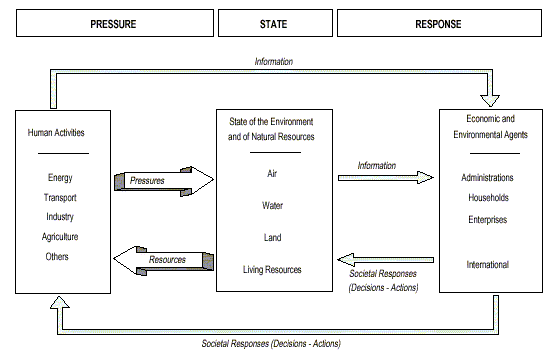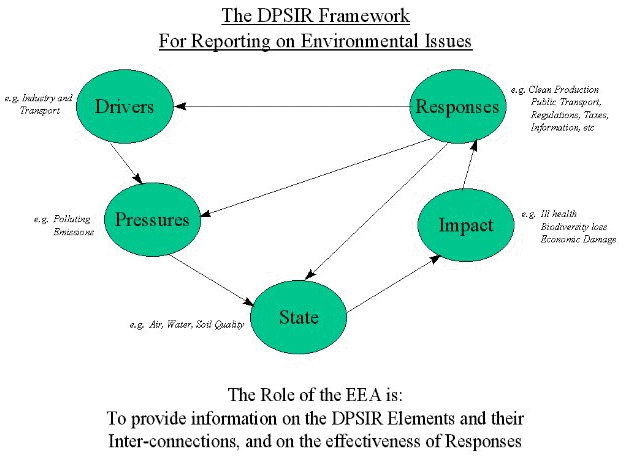|
Pressure State Response Frameworks
Much of the early work
on environmental indicators focused on the "state" of the environment - monitoring
physical changes in the natural environment. While this approach could inform
decision makers that something was going wrong, it did not explicitly deal with
why it was going wrong, or what anyone was doing about it. As a result a more
holistic approach was proposed which included an evaluation of human activities
that resulted in change - the "pressure", and social "responses" to try
to control damaging human activities.
Understanding
Change - The OECD Approach
View PDF:
English
French
The OECD core
set of environmental indicators is a commonly agreed set of indicators for OECD
countries and for international use. The purpose of these indicators is:
- to keep track of environmental
progress;
- to ensure integration
of environmental concerns into sectoral policies;
- to ensure integration
of environmental concerns into economic policies;
- to use indicators to
measure environmental performance and to help determine whether
countries are on track to sustainable development.
While early "Causal" frameworks
for environmental statistics tried to make one-to-one linkages among particular
stresses, environmental changes and societal responses, the OECD PSR framework
does not attempt to specify the nature or form of the interactions between human
activities and the state of the environment.
This simple PSR framework
merely states that human activities exert pressures (such as pollution
emissions or land use changes) on the environment, which can induce changes
in the state of the environment (for example, changes in ambient pollutant
levels, habitat diversity, water flows, etc.). Society then responds
to changes in pressures or state with environmental and economic policies and
programs intended to prevent, reduce or mitigate pressures and/or environmental
damage.

Pressure Indicators
These are often classified
into underlying factors or forces such as population growth, consumption or
poverty. The pressures on the environment are often considered from a policy
perspective as the starting point for tackling environmental issues, and, from
an indicator viewpoint when they are perhaps more readily available for analysis
since they can be derived from socio-economic, environmental and other monitiring
databases.
State Indicators
The state refers to the
condition of the environment that results from the above pressures, e.g. the
levels of air pollution, land degratation or deforestation. The staste
of the environment will, in turn, affect human health and well-being as well
as the socio-economic fabric of society. For example, increased land degradation
will lead to one or a combination of the following: decreased food production,
increased food imports, increased fertilizer use, malnutrition, etc. It
is important to have an understanding of both the State of the Environment as
well as the indirect effects. Indicators of state should be designed to be responsive
to the pressures and at the same time facilitate corrective action.
Response Indicators
The response component of
the PSR framework relates to the actions taken by society either individually
or collectivly, that are designed to ease or prevent negative environmental
impacts, to correct existing damage, or to conserve natural resources. These
responses may include regulatory action, environmental or research expenditure,
public opinion and consumer preference, changes in management strategies, and
the provision of environmental information. Responses should be designed to
act on the pressures but may at the same time also have an impact modifying
the indicators of state.
The PSR framework is now
widely used but is continuing to evolve. One of the main problems has been trying
to differentiate between pressure and state indicators, and the need to expand
the framework to deal more specifically with the needs for describing sustainable
development.
A development
of PSR has been the "Driving Force - State - Response" (DSR) framework
selected by the United Nations Commission on Sustainable Development.
Driving
Force - State - Response Framework
In the Driving Force - State
- Response Framework for Sustainable Development (DSR), the components are:
-
Driving Force - human
activities, processes and patterns that impact on sustainable development
-
State - the "state"
of sustainable development
-
Response - policy options
and other responses to changes in sustainable development
In the DSR framework, the
term "pressure" has been replaced by that of "driving force" in order to accommodate
more accurately the addition of social, economic, and institutional indicators.
In addition, the use of the term "driving force" allows that the impact on sustainable
development may be both positive and negative as is often the case for social,
economic, and institutional indicators.
The DSR framework is actually
a matrix that incorporates three types of indicators horizontally and the different
dimensions of sustainable development vertically, namely social, economic, environmental,
and institutional.
State of the environment
indicators in the DSR framework can be used to bring scientific findings from
the field and lab to the general public and decision-makers. To be effective,
in the sense that indicators steer action, the indicators should as a rule,
have an explicit target group in the country or region in mind. A set of indicators
should not only give information on the development in specific environmental
problem areas, but also give a general impression of the state of the environment.
Ideally, a set of indicators is a means devised to reduce a large quantity of
data to a simpler form, while retaining essential meaning for the question that
are being asked of the data.
Information on the environment
may be difficult to evaluate in isolation. Therefore, points of reference are
needed. Preferably, a set of indicators should be the same as or closely related
to the sets of indicators used in other countries and other regions of the same
country.
However,
even this model is changing, and the EU is now looking at the "Driving
Force - Pressure - State - Impact - Response" (DPSIR) Framework.
Driving Force-Pressure-State-Impact-Response
Framework
The Driving Force - Pressure
- State - Impact - Response Framework (DPSIR) provides an overall mechanism
for analysing environmental problems.
-
Driving
forces, such as industry and transport, produce
-
Pressures
on the environment, such as polluting emissions, which then degrade the
-
State
of the environment, which then
-
Impacts
on human health and eco-systems, causing society to
-
Respond
with various policy measures, such as regulations, information and taxes,
which can be directed at any other part of the system.

|





